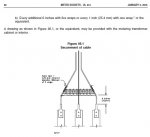StevenLeuck
Member
- Location
- Eugene, OR, USA
I've been researching this subject since yesterday without receiving any definitive reply so was hoping someone here in the Forums might be able to shed some light on this subject......
Early this week, out of the blue, we had a local book-learned electrical inspector (was never an electrician) turn down a service inspection because he wanted the phase conductors lashed together on both the line and load sides of the service conductors inside a 400A rated CT Cabinet. In my 43 years of managing electrical construction (after a short apprenticeship career) I have never had this requirement put on us. He claimed it was because the equipment (BLine 6067-HAL CT Mounting bus) had a sticker on it depicting the lashing and that since the manufacturer showed it, it MUST therefore be a requirement for a code-approved installation of the equipment in question. We asked for an NEC reference but he couldn't give one.
I searched the Forum for this subject but found only one ten year old thread. Among the responses was one from IWire who stated, without reference, that it depends on the rated fault current. Unfortunately I haven't been able to find any reference to this online.
I then contacted the Cooper/BLine metering people directly. They pointed me to UL 414 and a couple of specific articles in it. Unfortunately,unless you're willing to shell out $1,000 for a download of a UL Chapter, you can't get to it to even read it.
So,.... the bottom line is that we don't think the inspector is correct in assuming that since there's a sticker on the equipment that the lashing of conductors is required unless there is a specific need (eg, fault current threshold of some sort) to do it and that diagram on the sticker is only there for reference if needed. Has anyone out here had experience with this and/or has a specific reference to what that threshold might be, if there is one? I can't find anything in the NEC about it and none of my guys are familiar with it either.
Looking/hoping for some collective assistance here.
Thanks!
PS, the attachment is a simile of the sticker that is on the equipment that BLine emailed me
Early this week, out of the blue, we had a local book-learned electrical inspector (was never an electrician) turn down a service inspection because he wanted the phase conductors lashed together on both the line and load sides of the service conductors inside a 400A rated CT Cabinet. In my 43 years of managing electrical construction (after a short apprenticeship career) I have never had this requirement put on us. He claimed it was because the equipment (BLine 6067-HAL CT Mounting bus) had a sticker on it depicting the lashing and that since the manufacturer showed it, it MUST therefore be a requirement for a code-approved installation of the equipment in question. We asked for an NEC reference but he couldn't give one.
I searched the Forum for this subject but found only one ten year old thread. Among the responses was one from IWire who stated, without reference, that it depends on the rated fault current. Unfortunately I haven't been able to find any reference to this online.
I then contacted the Cooper/BLine metering people directly. They pointed me to UL 414 and a couple of specific articles in it. Unfortunately,unless you're willing to shell out $1,000 for a download of a UL Chapter, you can't get to it to even read it.
So,.... the bottom line is that we don't think the inspector is correct in assuming that since there's a sticker on the equipment that the lashing of conductors is required unless there is a specific need (eg, fault current threshold of some sort) to do it and that diagram on the sticker is only there for reference if needed. Has anyone out here had experience with this and/or has a specific reference to what that threshold might be, if there is one? I can't find anything in the NEC about it and none of my guys are familiar with it either.
Looking/hoping for some collective assistance here.
Thanks!
PS, the attachment is a simile of the sticker that is on the equipment that BLine emailed me


